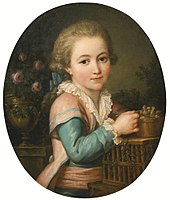Marie-Victoire Lemoine
Marie-Victoire Lemoine (French: [ma.ʁi vik.twaʁ lə.mwan]; 1754 – December 2, 1820) was a French classicist painter.
Marie-Victoire Lemoine | |
|---|---|
| File:Self portrait of Marie-Victoire Lemoine.jpg Marie Victoire Lemoine, Portrait of the Artist ca. 1780/1790 | |
| Born | 1754 Paris, France |
| Died | December 2, 1820 (aged 65–66) Paris, France |
| Nationality | French |
| Known for | Painting |
Life
Born in Paris, Marie-Victoire Lemoine was the eldest daughter of Charles Lemoine and Marie-Anne Rousselle. Her sisters, Marie-Denise Villers and Marie-Élisabeth Gabiou, also became painters. However, unlike her sisters, she remained unmarried and became one of the few women in contemporary art that made a living through painting.
She was a student of François-Guillaume Ménageot in the early 1770s, with whom she lived and worked in a house acquired by the art dealer Jean-Baptiste-Pierre Lebrun, next to the studio of Élisabeth-Louise Vigée-Le Brun (1755–1842), France's leading woman painter. From 1779, Marie-Victoire Lemoine lived in her parents' home until she moved in with her sister Marie-Elisabeth, where she remained even after her sister's death. She died six years after her last exhibition, aged sixty-six.
Work
Marie-Victoire Lemoine mainly painted portraits, miniatures, and genre scenes. She took part in numerous Salons,[1] for example Pahin de la Blancherie's Salon de Correspondance in 1779,[2] where she exhibited a portrait of the Princess Lamballe (57 x 45 cm). Following this salon, she continued to display her works of art to the public in the salons of 1796, 1798, 1799, 1802, 1804 and 1814.
References
- ^ "Marie Victoire Lemoine | The Interior of an Atelier of a Woman Painter | The Met". The Metropolitan Museum of Art, i.e. The Met Museum. Retrieved 2017-03-08.
- ^ Auricchio, Laura (2002-01-01). "Pahin de la Blancherie's Commercial Cabinet of Curiosity (1779–87)". Eighteenth-Century Studies. 36 (1): 47–61. JSTOR 30053338.
Gallery
-
Marie-Victoire Lemoine's The Interior of an Atelier of a Woman Painter, at first interpreted as Vigée Le Brun with a student. Later interpretation is that the subject is Marie-Victoire herself with her sister Marie-Elisabeth[1]
-
The Two Sisters
-
Marie-Victoire Lemoine (attr) Portrait of a boy feeding two birds
-
Portrait of Zamor
- ^ www.metmuseum.org https://www.metmuseum.org/art/collection/search/436875. Retrieved 2020-06-16.
{{cite web}}: Missing or empty|title=(help)

![Marie-Victoire Lemoine's The Interior of an Atelier of a Woman Painter, at first interpreted as Vigée Le Brun with a student. Later interpretation is that the subject is Marie-Victoire herself with her sister Marie-Elisabeth[1]](http://upload.wikimedia.org/wikipedia/commons/thumb/4/49/Marie-Victoire_Lemoine_-_The_Interior_of_an_Atelier_of_a_Woman_Painter_MET_57-103.jpg/155px-Marie-Victoire_Lemoine_-_The_Interior_of_an_Atelier_of_a_Woman_Painter_MET_57-103.jpg)


